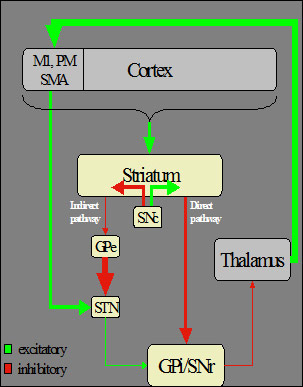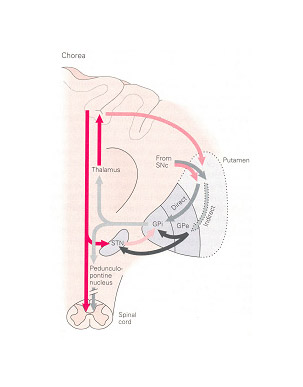Basal ganglia
Basal ganglia regulate muscle contraction, muscle force, multi-joint movements, and the sequencing of movement
- Basal Ganglia have no direct connection either to or from the spinal cord
- The information for these function is provided primarily by the cerebral cortex
- The output of the basal ganglia is via motor areas of the cerebral cortex and the pedunculopontine nucleus (located in brain stem)
- Stimulation of the pedunculopontine nucleus elicits rhythmical behaviors such as locomotor patterns (especially known in the cat to be important in the control of locomotion)
Basal ganglia receive their main input from the cerebral cortex, and send the majority of their output back to the cortex via thalamus
- THIS CIRCUIT IS
- CORTICO-BASAL GANGLIA-THALAMO-CORTICALLOOP
- Basically two main pathways through the basal ganglia:
- THE DIRECT AND INDIRECT PATHWAYS
Direct Pathway : inhibits output neuron
Indirect Pathway : produces final excitation of the output neuron
This opposite action is often linked to an neuronal brake and accelerator
(Motor Pattern Generator)
A. Components of Basal Ganglia
- Corpus Striatum
- Striatum ----- Caudate Nucleus & Putamen
- Pallidum ----- Globus Pallidus (GPi, GPe)
- Substantia Nigra
- Pars Compacta (SNc)
- Pars Reticulata (SNr)
- Subthalamic Nucleus (STN) Ventral Striatum and Ventral Pallidum
- Nucleus Accumbens Septi
- Non cholinergic portion of Substantia Innominata
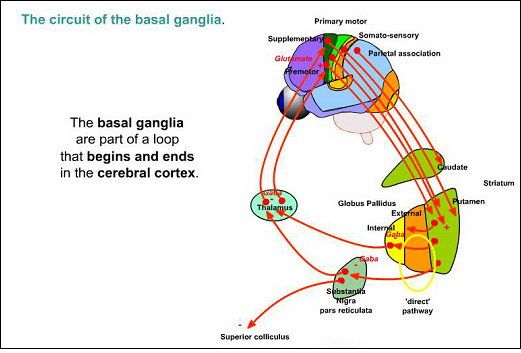
B. Basal Ganglia Connections
- Input Portion
- STRIATUM (Caudate Nucleus and Putamen)
- Output Portion
- PALLIDUM (Globus Pallidus)
- SNr (Substantia Nigra, Pars Reticulata)
- So what is the basal ganglia circuit doing?
- The "Brake" hypothesis
- B.G. essentially acts like a brake to prevent unwanted movement.
- Excitation of STN via motor input leads to diffuse increase in inhibition.
- Excitation of the striatum in one motor circuit decreasing this inhibition focally thus "releasing the brake" for the selected movement.
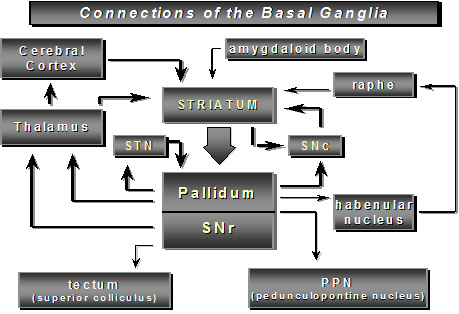
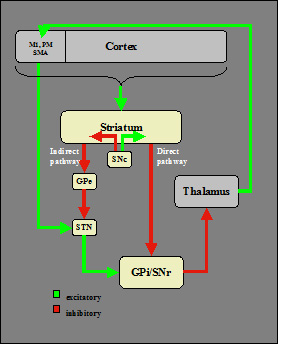
Basal Ganglia Circuit
- Striatum receives input from all cortical areas except V1 & A1
- inputs are roughly topographical (multiple parallel circuits)
- GPi/SNr are the major output nuclei
- Output is inhibitory
- GPi/SNr neurons have high baseline firing rates (baseline = inhibition)
- GPi/SNr input from the striatum is focal and inhibitory, where as input from the STN is diffuse and excitatory
- Direct vs. indirect striatal pathways have opposing effects (inhib. vs. excit.)
- Net effect fo Dopamine →Excitation of the thalamus
C. Functional Consideration
- Selection of "Preprogramed (learned) motor plans"
- Basal Gangla Circuit ---- Selection Mechanism
- Selection Inability -------- Akinesia and Hypokinesia
- Faulty Selection ----------- Hyperkinesia
- Generation (learning) of motor programs
- Programming of several motor fragments into complex motor routines
- Cerebral Palsy ------------- Disordered motor program
- The Basal Ganglia - Their Motor Functions
The Basal Ganglia, like the cerebellum, are another accessory motor system that functions usually not by itself but in close association with the cerebral cortex and corticospinal motor system.
In fact, the basal ganglia receive virtually all their input signals from the cortex itself and also return almost all their output signals back to the cortex.
Relation of basal ganglia circuitry to the corticospinal -cerebellar system for movement control
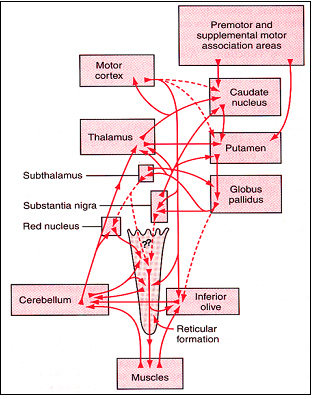
D. Basal ganglia and Motor learning
A critical role of the basal ganglia in motor learning is the mediation during basicimplicit learning.
A series of imaging studies have shown striatal activation when healthy subjects are engaged in basicimplicit sequence learning (Doyon et al., 1996; Krebs et al., 1998)
Parkinson's disease
exhibit impaired performance on the serial reaction time task (SRT-task) which is a typical paradigm to determine the mediating neuroanatomy of implicit learning (Willingham and Koroshetz,1993)
E. The Putamen Circuit
Function of the Basal Ganglia in Executing Patterns of Motor Activity
1. To control complex patterns of motor activity
- Writing of letters of the alpahbet
- Cutting papers with scissors
- Throwing a baseball
The putamen circuit has its inputs mainly form those parts of the brain adjacent to the primary motor cortex but not much from the primary motor cortex itself. Then its outputs do go mainly back to the primary motor cortex or closely associated premotor and supplementary cortex.
Abnormal Function in the Putamen Circuit
- Athetosis: lesions in the globus pallidus frequently lead to spontaneous and often continuous writhing movements of a hand, an arm, the neck, or the-face movements
- Hemiballisms: a lesion in the subthalamus often leads to sudden flailing movements of an entire limb
- Chorea: multiple lesions in the putamen lead to flicking movements it the hands, face, an other parts of the body
F. The Caudate Circuit
Cognitive Control of Sequences of Motor Patterns
The term cognition means the thinking processes of the brain, using both the sensory input to the brain and the information already stored in memory.
Most of our motor actions occur as a consequence of thoughts generated in the mind, a process called cognitive control of motor activity.
Caudate Nucleus: plays a major role in this cognitive control of motor activity.
Function of the Basal Ganglia to Change the Timing and to Scale the Intensity of Movements
Two important capabilities of the brain in controlling movement are
- To determine how rapidly the movement is to be performed and
- To control how large the movement will be.
The caudate and putamen receive input from widespread cortical and subcortical structures and feed it to the globus pallidus.
The globus pallidus feeds this information to the ventrolateral thalamic nucleus, which funnels (or focuses) it back onto the supplementary motor area (SMA).
In this way, the basal ganglia are involved in the selection and initiation of voluntary movements.
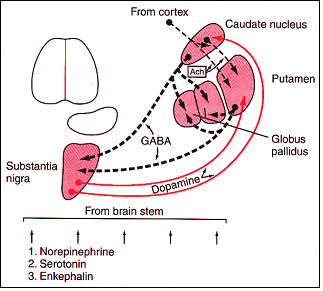
Functions of Specific Neurotransmitter Substances in the Basal Ganglia System
- Dopamine pathway
- Gamma-aminobutyric acid (GABA) pathway Acetylcholine pathway
- Multiple general pathway
Clinical Syndrome Resulting from the Damage to the Basal Ganglia
A. Parkinson's Disease
Decreased output of SNc dopaminergic projections
- Decrease inhibition in direct pathway
- Increase excitation in indirect pathway
Net effect:
More inhibition of thalamus and therefore less excitatory input to motor cortex
Parkinson's Disease, known also as paralysis agitans, results from widespread destruction of that portion of the substantia nigra, the pars compacta, that sends dopamine-secreting nerve fibers to the caudate nucleus and putamen.
Characteristics: Rigidity, Involuntary tremor, Akinesia
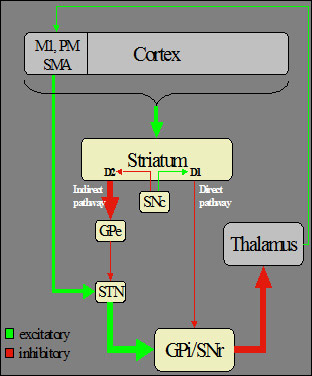
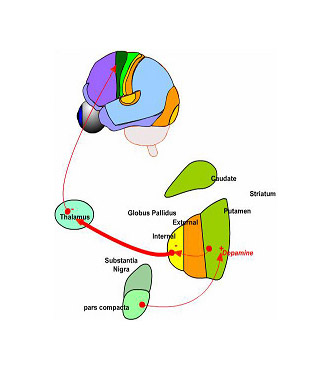
A. Huntington's Disease
Cell loss in the striatum that seems to affect the indirect pathway disproportionately
Net effect:
Less inhibition of the thalamus and therefore excessive excitation of motor cortex
